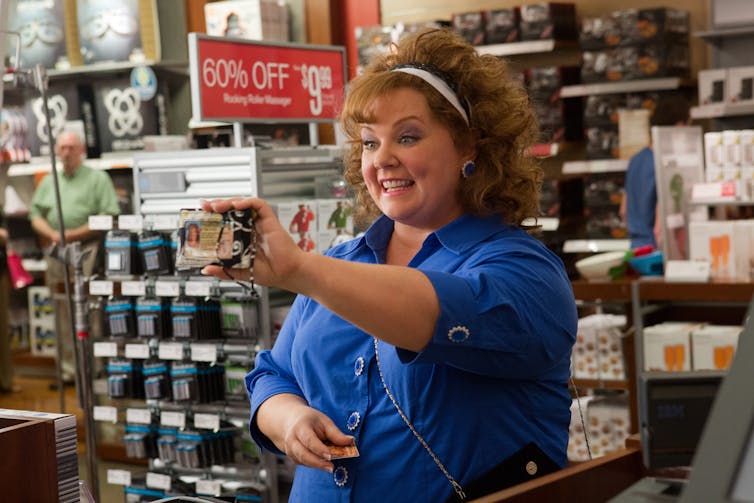Source: The Conversation (Au and NZ) – By Amanda Howell, Senior Lecturer, Griffith University
In this series, our writers explore their best worst film. They’ll tell you what the critics got wrong – and why it’s time to give these movies another chance.
When New York Observer film reviewer Rex Reed trashed Seth Gordon’s 2013 comedy Identity Thief, calling it “dreck” and a “chunk of junk”, few disagreed.
But his dismissal of Melissa McCarthy as a “gimmick comedian who has devoted her short career to being obese and obnoxious with equal success” sparked immediate backlash in defence of her talent.
And it is McCarthy’s talent that brings us back to Identity Thief, one of our favourite bad films.
Identity Thief works on the premise that a fat woman can steal a man’s identity because she is effectively invisible. But, at the same time — as Reed’s mean-spirited comments confirm — her fat body is all-too-visible, pitiable and laughable.Dubbed an ill-conceived ripoff of John Hughes’ buddy comedy Planes, Trains and Automobiles (1984), Identity Thief earned a 19% rating from Rotten Tomatoes for its haphazard plotting, lazy reliance on cliché, and politically incorrect humour.
As Roxane Gay has pointed out, McCarthy’s character Diana is written as a stereotype of fat femininity: an outsider with no friends, family, future. Or taste.
We don’t disagree. But the weaknesses of Identity Thief provided grist for McCarthy’s comedic mill. The film also gave McCarthy an opportunity to demonstrate her ability to tap into the emotional centre of even the most unlikely or unlikable character — a skill that has since won her praise.
Relishing bad taste
When Identity Thief was released, McCarthy was best known for crafting adorable, quirkily likeable characters for the small screen in Gilmore Girls (2000-07) and Mike & Molly (2010-16).
Her break out big-screen role was Megan, the idiosyncratic sister of the groom in Bridesmaids (2011).
Sexually voracious and atrociously attired in Kangol Ventair caps, orthopedic sandals and pearls, Megan was the first of many McCarthy creations that speaks to her sympathy for — and delight in — the outrageously-dressed, tastelessly-coiffed and badly-behaved.
Entirely the product of McCarthy’s improvisational comedy, Megan incarnates what Susan Sontag in Notes on Camp (1964) referred to as a “tender feeling” which “relishes, rather than judges” what others might deride as bad taste.
With its origins in the gay male subculture of drag performance, camp is strongly identified with ironic gender play – a key element of McCarthy’s comedy.
Read more: How camp was the Met Gala? Not very
In control of the joke
Identity Thief was originally written for two male co-stars. Producer and co-star Jason Bateman who plays Sandy Patterson, the man whose identity Diana steals, asked for the second role to be rewritten with McCarthy in mind. The scriptwriters appeared to struggle with McCarthy’s character, falling back on stereotypes in depicting Diana as an utterly isolated loser.
But we see McCarthy taking control of the joke through a high camp performance. She creates an outrageous female antihero whose larger-than-life masquerade of femininity is a survival strategy.

The production’s costume designer, Carol Ramsey, recalls that Diana’s wardrobe of candy bright floral and gingham was modelled on the real-life horrors of plus size fashion.
Combined with similarly garish makeup, Diana is styled as the embodiment of white trash, impulse-driven consumerism. Her visual excesses are set in contrast to the modest appeal of hard-working, underpaid family man Sandy.
But Diana never quite subsides into being just a tacky, pathetic fashion victim addicted to shopping.
Instead, she is transformed by McCarthy into something else: a female impersonator who glories in excesses of style and appetite. She enjoys her feminine masquerades and uses them to counter social and economic disempowerment.
A second glance
Identity Thief also showcases McCarthy’s virtuosity as a physical comedian.
Animated by McCarthy’s theatrically-manic, violent, physical comedy, Diana is relentlessly energetic and unscrupulous beneath her cartoonishly awful attire. She uses her surface appearance of harmlessness and her impressive improvisational talents (not so different from McCarthy’s own) as weapons.
Angry and aggressive in response to her marginalisation — and quick with a punch to the larynx — Diana is ultimately an unlikely but oddly effective femme fatale.
McCarthy has continued to explore the possibilities of feminine masquerade, camp irony and physical comedy in films like Tammy (2014), Spy (2015), and The Boss (2016).
Her Emmy award winning 2017 drag performance as Sean Spicer on Saturday Night Live was satiric yet empathetic.
Portrayed as both a bully and victim, Spicer confirmed McCarthy’s ability to engage emotionally with the most unlikely or unlikable characters.
While this talent was overlooked in negative reviews of Identity Thief, McCarthy received praise for her portrayal of Lee Israel in Can You Ever Forgive Me? (2018). Like Diana, Lee is unfashionable, difficult to like, and has a talent for (literary) impersonation drawn from her professional skill set.
Diana isn’t McCarthy’s most lauded performance, but she’s a lot more interesting and compelling than Identity Thief deserves — and makes this bad film worth a second look.
– ref. My Best Worst Film: Identity Thief — yes the movie is bad, but Melissa McCarthy is a comic genius – https://theconversation.com/my-best-worst-film-identity-thief-yes-the-movie-is-bad-but-melissa-mccarthy-is-a-comic-genius-149451








